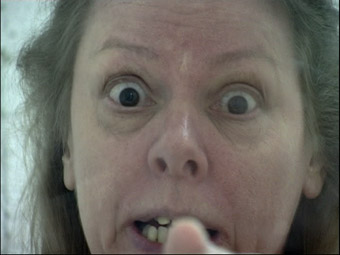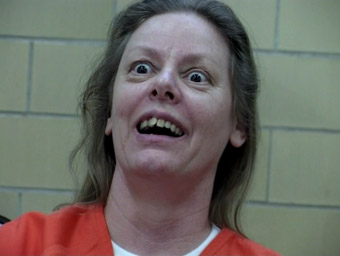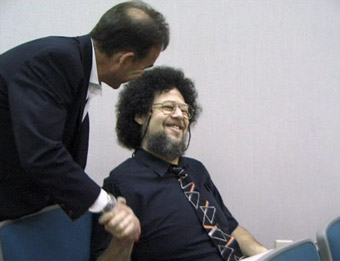This
disk contains both of Nick Broomfield's documentaries on
Aileen Wuornos. The first film, Aileen Wuornos:
The Selling of a Serial Killer, his reviewed here.
In
1992, English documentary film-maker Nick Broomfield was
asked to direct a series of films about serial killers,
something he had little real interest in doing. When looking
through the supplied material, however, he found one case that commanded
his attention, one that appeared to turn the serial killer cliché on its head – instead
of a male killer murdering female prostitutes, a female prostitute named Aileen Wuornos had killed her male clients. Broomfield contacted
the woman's lawyer and was told that for $25,000 an interview
could be arranged. For Broomfield, this was the kicking
off point for Aileen Wuornos: The Selling of a Serial Killer, a documentary that was to be less about Wuornos than the exploitation of her story
by almost everyone involved in the case. Broomfield's
eventual interview with Wuornos did more than give his
film it's needed climactic footage, it marked the start
of a relationship between him and Wuornos that – kept
alive over the years through witten correspondence – bordered
on friendship.

Broomfield
had no plans to make this follow-up film, and was in the
middle of shooting his documentary Biggie and
Tupac when one morning he was served with a subpoena
to appear at Wuornos's pre-execution trial. Suspecting
he was going to be asked for his opinion as someone who
knew Wuornos, he was surprised when he was questioned
on the editing techniques used in his earlier film in
an attempt to discredit the evidence it presented. As
Broomfield watched this new aspect of the story unfold
he witnessed something else, a change in Wuornos that
went beyond the physical – after twelve years of protesting
that she was acting in self defence, she was now openly claiming
that there were no attempts to assault her and that all
of the killings were motivated by robbery. On top of that
she was objecting to her own defence witnesses, a move that was effectively
sabotaging her trail. As Broomfield had the requisite video and sound recording equipment
for the Biggie and Tupac shoot,
he took it and long-time collaborator Joan Churchill with
him and began work on what proved to be the concluding
half of an extraordinary story.
If
the first film was primarily concerned with the exploitation
of Wuornos's story, then Life and Death of a Serial
Killer is more focused on Wuornos
the person and getting at the truth behind her motivition to kill. The only one in a position to provide this information is, of course, Wuornos herself,
and in her first meeting with Broomfield, whom she greets
with a warmly enthusiastic "Hi,
Nick!" she seems to have a single intention: to go
on record to set things right with God before going to her death by admitting that she actually killed all seven men
in cold blood. But
from the start Broomfield suspects that something isn't right. Twelve years on Death Row in a room without
sunlight have left Wuornos looking old beyond her years
and have dramatically cranked up her paranoia – and as
the film progresses she expounds, sometimes manically,
on her conviction that she was being watched by the police
even before she committed the first crime, that they
let her continue in order to trade on the more lucrative
Serial Killer label, and that they have for years been
bombarding her with sonic waves. Initially quite
lucid, her mood can switch in an instant, her face contorting
into a mask of ferocious rage, then returning to its normal,
sometimes openly friendly self.
Broomfield
becomes increasingly convinced that the real reason that Wuornos has changed her plea is to accelerate an end to the
her increaingly intollerable Death Row existence and seemingly never-ending stream of pointless
court appearances. Aileen, he surmises, just wants to die,
a belief she herself does little to discourage.
The moral problem, from Broomfield's viewpoint,
is that she has actually lost her mind and as a result should not be subject to execution. The Christian Right
(an oxymoron if ever there was one) inevitably viewed Wuornos's
change of heart as a final admission of guilt by an irredeemably evil
woman, and the process of killing her is kicked
off with some speed by non other than Jeb Bush (George Dubya's
brother), who is up for re-election on a law-and-order and execution
ticket, which Wuornos's death would be perfectly timed
to publicise.

The
ghost of the first film soon starts to rear its head – politicians
are still using Wuornos to promote their personal and professional agendas and the facts of the
case remain as uncertain as ever. This is reflected in Broomfield
and Churchill's extensive use of extracts from the first
film for background, some of which is considerably
expanded on here. Watched side-by-side with the earlier film, as this DVD release allows, this may seem a little like space filling,
but ten years separated the production of the two films and as made-for-TV works there would be no guarantees that the audience for the second film would have even seen the first, or have easy access to it for recall purposes.
Broomfield's
personal journey once again invites audience identification
and involvement. More information is provided on Aileen's
early background and we get to meet her closest friend
Dawn, who shows us some of Aileen's extraordinary artwork (which can only be properly seen when held up to the light). She also claims forcefully that "gays weren't invented"
until about 15 years ago, to which Broomfield responds that it was at British public schools that the invention took place, adding as an afterthought, "us and the Greeks." We also
meet Aileen's childhood friends Michelle – who takes us on a censored
tour of the neighbourhood of their youth and talks in
court about the brutality of Aileen's grandfather – and
Dennis, who as a child used to live in the woods with
Aileen after she was thrown out of her home. We learn
of Aileen's early pregnancy, her marriage to the elderly Lewis
Fell (which ended when she assaulted him with his own
walking stick), and (albeit fleetingly) of the local peadophile
who was rumoured to be the father of Aileen's child. Broomfield
also tracks down Aileen's natural mother, a sad and frail
woman who requests that he ask her daughter for
her forgiveness, something the still bitter Wuornos angrily
dismisses with a furious "She can go to hell!"
We also see Broomfield re-introduce himself to Steve Glazer,
whose career as a lawyer effectively stuttered to a halt when the first film was shown – as he shakes Broomfield's
hand with a disbelieving half-smile, he says
to him wearily, "Fuck you. Fuck you and your documentary.
Don't talk to me."
Though
more fact-filled than the first film, it is again Broomfield's
personal journey that proves the most compelling aspect. This is
particularly true of his encounters with Aileen, who always
greets him affectionately by his first name and after
one particularly difficult but revealing encounter tells
Broomfield as she leaves: "I'll always remember you
and love you. I love you so much." It is during this
interview that the most revealing conversation is recorded – between interview takes while
Churchill is reloading the camera, Aileen
talks to Broomfield in a hushed whisper and effectively confirms his
suspicions about her plea change. Unbeknown to her, Churchill
has finished changing tapes and is filming the still visible Broomfield
and recording the whole thing.

This
leads to a genuinely extraordinary final interview with
Wuornos, recorded the night before her execution. She
is kept shackled and some distance from Broomfield, who just can not forget
that he is first and foremost a documentary film-maker, and
despite their long-standing friendship, Aileen's increasingly angry protestations, and the fact that this is the
last time he will see her alive, he continues to press
her for confirmation of her earlier whisperings. Inevitably
Aileen loses her rag, but in the middle of her seemingly
rambling anger repeats a proclamation from her first trail
about society condemning a raped woman to death, and in
that moment kicks against her own more recent rejection of the self-defence claim. As she is being
led away in a state of fury, Broomfield calls across to
her, almost pleadingly, "Aileen! I'm sorry!"
It's a testament to our involvement in with both subject and filmmaker that
this is an almost heartbreaking moment.
By
then it is hard to know where to stand on Aileen's story,
as the twelve years on Death Row in virtual isolation
have clearly driven her mad, which although clear to an even a half-aware viewer, is something the three psychiatrists appointed by good old
Jeb Bush took just fifteen minutes to refute, allowing
this conveniently timed execution to go ahead. Though
the end is inevitable, Broomfield uses the media circus
that has gathered outside of the prison to give interviews
to reporters and put across his view that the state has
knowingly executed a woman who has lost her mind.
Aileen:
Life and Death of a Serial Killer is a sad indictment
of a system that seems to deal with injustice using a process that is riddled with its own set of injustices. Aileen Wuornos
was tried, endlessly re-tried and eventually executed,
and nothing seems to really have been learned from the
case. Instead of trying to understand this woman and
her crimes, many of those in authority and connected
to her personally have merely seeked to profit from it, and you are left with the sense that Aileen's final paranoid
ramblings about police and political corruption, though
absurd in their scale and illogical in their detail, may
still have had an essence of truth.
Unlike
the first film, which was filmed on 16mm, Life and
Death of a Serial Killer was shot on DV-CAM, a
popular, relatively low-cost format for TV production (this
was shot for TV screening). The video look is immediately
evident, but the transfer itself is clean, crisp and boasts
a good level of detail. Contrast is pretty much spot on
throughout. The included extracts from the first film tend
to stand out because of their 16mm origin (though have been
well graded to mix with the new footage) and included TV
and police video footage is of varying quality. Some TV
footage appears to have been shot directly off the screen
rather than transferred to tape. A few compression artefacts
are occasionally visible, but this can be the result of
shooting on DV in low light conditions rather than a fault
with the transfer.

For
the large part a functional stereo mix – most of the interview
material is front and centre, as it should be, but music
and some sound is spread wider. The mix is clear throughout
and serves its purpose perfectly well.
Part
of a two-film disk from Optimum, the extras for both films
are detailed in my review of Aileen Wuornos: The Selling of a Serial Killer. Click here
to be taken to that review.
Again
there is an Introduction to the Film
by Broomfield, at 3 minutes slightly longer than the intro
to the first film and gives a useful lead-in to the film
for first-timers. As with the first film, much of this is
repeated in the main interview with the director, and some
in the film itself.
What
I do feel compelled to comment on, specifically in regard this film, is not so much was is included but what is missing.
The 20 minute Interview With Nick Broomfield
gives a great deal of information about how Broomfield worked with
Wuornos, how specific scenes were shot and handled, how
he feels about the death penalty, his working relationship
with Joan Churchill, and the state of television documentary
today. When the film was first screened on Channel 4 in
the UK, however, it was followed by a short interview with
Broomfield in which he went into some detail on what was
going on off camera in that final interview with Wuornos.
What the audience did not see was that as the interview
progressed, more and more guards came in and stood behind Broomfield and Churchill, so that although we see Wuornos
seated alone with two guards, what she is seeing is not
just Broomfield and Churchill, but a small army
of the very people who would soon lead her to her death.
Knowing this puts a very different slant on that interview,
and it's a shame that information is not included here.
As
a whole, both Aileen Wuornos:
The Selling of a Serial Killer and Aileen:
Life and Death of a Serial Killer make for compelling
but ultimately sad viewing. The second film, especially,
sees the barrier between film-maker and subject almost completely
torn down, as Broomfield and his first film become part
of the evidence in a trial that is one the second film's key components. Broomfield's personal journey becomes
a quest for truth that we can't help but become involved
in, and even in her wildest moments, Wuornos remains a fascinating
and oddly sympathetic figure. That Wuornos's story as told
here is more complex and ultimately more gripping than it
comes across in the acclaimed feature film of her story,
Monster,
is a testament to Wuornos herself, the almost inevitable
superiority of the documentary format in communicating the
reality of a situation, and Broomfield's persistent yet
unusually personal approach.
Despite
gripes I may have had with some Optimum releases in the
past – the cropped picture on Lawless
Heart, for example, I'll happily admit
that they have put together a good package here. In the
US you have to buy the films separately and they are almost
completely devoid of extras (you can also buy the second
film in a double pack with Monster)
– to get both films plus a 20 minute interview with the
engaging Broomfield for a standard single disk price is
something of a bargain. Highly recommended.
|